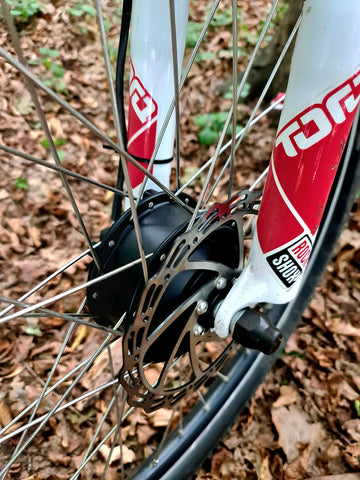If you're an avid cyclist, you understand the crucial role that braking performance plays in both safety and ride quality. One essential component of your bike's braking system is the disc brake rotor. In this comprehensive guide, we'll delve into the intricacies of disc brake rotors and equip you with the knowledge needed to select the perfect rotor for your biking needs.
The Basics of Disc Brake Rotors
Before we dive into the nitty-gritty details, let's establish a clear understanding of what disc brake rotors are and how they operate in conjunction with brake calipers. In essence, a disc brake rotor is a circular metal braking surface that attaches to your bike's wheel hub. When you engage the brake lever, the brake caliper clamps down on the rotor, creating friction that slows down or stops the wheel's rotation.

Types of Disc Brake Rotors
Disc brake rotors come in two main types: floating and solid rotors. Floating rotors are designed with a central carrier that allows the braking surface to expand and contract independently from the carrier. This design helps to reduce heat-related stress and minimize the risk of warping. On the other hand, solid rotors have a one-piece construction, making them simpler and often more affordable.
Each type has its own set of advantages and disadvantages. Floating rotors excel in heat dissipation and are a preferred choice for high-performance applications, while solid rotors are durable and cost-effective, making them suitable for everyday riders.
Rotor Sizing and Compatibility
The size of your disc brake rotor plays a significant role in determining your bike's braking performance. Larger rotors generally provide more stopping power, but they also add weight to your bike. It's crucial to choose a rotor size that's compatible with your bike's frame and fork. Refer to your bike's specifications or consult with a professional mechanic to ensure a proper fit.

Understanding Rotor Materials
The materials used in disc brake rotors can significantly impact their performance and longevity. Common materials include stainless steel and aluminum. Stainless steel rotors are known for their excellent durability and corrosion resistance, making them a popular choice among mountain bikers. Aluminum rotors, on the other hand, are lightweight and offer good heat dissipation, but they may wear down faster.
Heat Management and Cooling Technology
Braking generates a substantial amount of heat, which can affect the overall performance of your brakes. To counteract this, some rotors come equipped with advanced cooling technologies. Vented rotors feature cutouts that promote better airflow, while heat sinks use additional fins to dissipate heat more efficiently. These technologies help prevent brake fade and maintain consistent braking performance.
Rotor Designs and Patterns
Disc brake rotors are available in various designs and patterns, each offering unique benefits. Smooth rotors provide even braking force and are less prone to noise, making them suitable for road cycling. Drilled and slotted rotors, on the other hand, are popular among mountain bikers for their enhanced cooling and water-shedding capabilities. However, they might be more prone to noise and wear.
Factors Influencing Brake Performance
Selecting the right disc brake rotor involves considering factors such as your riding style, terrain, and weather conditions. If you're a downhill enthusiast tackling steep descents, a larger rotor might be your best bet. Conversely, road cyclists may prioritize lightweight options and smooth rotors for consistent stopping power.
Maintenance and Longevity
To ensure your disc brake rotors provide optimal performance throughout their lifespan, proper maintenance is essential. Regularly inspect the rotor's surface for signs of wear, unevenness, or debris. Clean the rotor and brake pads with isopropyl alcohol, and avoid using harsh chemicals that could compromise braking performance. When not in use, store your bike in a dry, cool environment to prevent corrosion.
Upgrading Your Disc Brake Rotors
As you progress in your cycling journey, you might consider upgrading your disc brake rotors to enhance your bike's overall performance. If you notice diminished braking power, excessive noise, or uneven wear on your current rotors, it might be time for an upgrade. Upgraded rotors can provide better modulation, improved heat dissipation, and a more consistent braking feel.
Step-by-Step Guide to Choosing the Right Rotor
Selecting the right disc brake rotor involves several key steps:
- Determine your bike's compatibility and current rotor size.
- Consider your riding style and preferred terrain.
- Choose an appropriate rotor design based on your needs.
- Evaluate different rotor materials and their benefits.
Installation and Bedding-In Process
Installing new disc brake
rotors is a straightforward process, but proper bedding-in is crucial for optimal performance. After installation, find a safe area and repeatedly brake from a moderate speed until you feel consistent stopping power. This process deposits an even layer of brake pad material on the rotor's surface, enhancing braking efficiency.
Comparing Popular Disc Brake Rotor Brands
Several reputable brands offer a wide range of disc brake rotors tailored to various biking disciplines. Shimano, SRAM, and Avid are among the industry leaders, each with their own innovative features and designs. When comparing brands, consider factors such as compatibility, rotor design, and user reviews to make an informed decision.
Conclusion
Disc brake rotors are an integral part of modern bike braking systems, offering superior stopping power and reliability. Understanding the different types, materials, sizes, and maintenance considerations will help you find the right rotor for your bike and ensure a safe and enjoyable riding experience.











